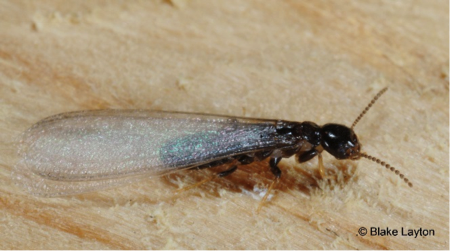Eastern Subterranean Termites, No 2
Your Extension Experts
Related News
May 12, 1997
March 17, 1997

Reticulitermes flavipes
Eastern subterranean termites are some of the most damaging insect pests in the state, annually causing millions of dollars in property damage, despite the millions of dollars that are spent each year to control them. These social insects play a beneficial role in our forests and landscapes, but when they invade houses and commercial buildings, the situation is much different. An established termite colony can contain hundreds of thousands of termites. Most are workers, which are wingless, white, and sightless. The black, winged insect you see here is a swarmer, or reproductive termite (about 3/8 inches long including the wings). Swarmers emerge only once per year, usually in the spring, and they are never alone. Usually there will be several hundred to a few thousand swarmers, all emerging simultaneously. Their goal is to mate and attempt to begin a new colony. But it is not the swarmers you need to worry about—it is the established termite colony from which they emerged. Termite colonies do not produce swarmers until they have been established for several years. Finding eastern subterranean termite swarmers inside a building is a sure sign the building is infested with termites and needs to be professionally treated. Seeing swarmers emerging from a stump or log in the lawn is not necessarily cause for concern, but it can still serve as a reminder to check your termite coverage (“When was the last time we had this building treated for termites and is the contract still in force?”). Actually, this is a good question to ask yourself even if you do not see swarming termites this year. Eastern subterranean termites swarm primarily in the spring, but swarming can begin as early as January in coastal areas and continue into June in the northern portion of the state. Although termites only swarm one time per year, the hundreds of thousands of workers comprising a termite colony remain active year round, eating 24 hours a day 365 days a year.
Control: Termite control is not a do-it-yourself project! You need to hire a licensed commercial pest control company to make sure your house is protected from termites. See Extension Publication 2568, Protect Your House from Termites for information on termite biology, how to hire a pest control company, and how to avoid conditions that increase risks of termite attack. If you plan on building a house soon see Extension Publication 2765, What Homebuilders Need To Know About Termites.
Blake Layton, Extension Entomology Specialist, Mississippi State University Extension Service.
The information given here is for educational purposes only. Always read and follow current label directions. Specific commercial products are mentioned as examples only and reference to specific products or trade names is made with the understanding that no discrimination is intended to other products that may also be suitable and appropriately labeled.